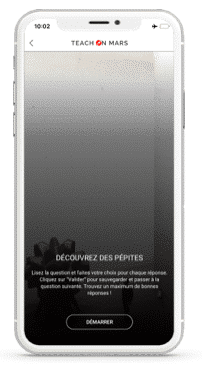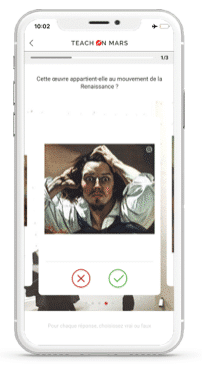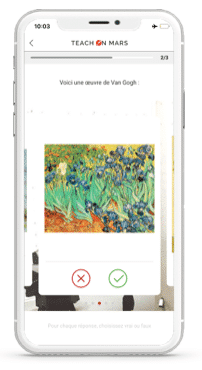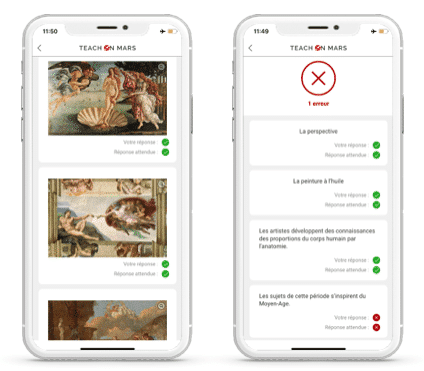You requested it and waited, we dreamed of it and it’s finally here…the latest Teach on Mars activity has made its grand entrance into the solution to get the year off to a great start: welcome to Multiquiz!
The first advantage is the very principle of Multiquiz, which completes the range of activities in the Teach on Mars solution: for one single question, there are several possible answers. This activity will enable designers to propose more extensive questions, with a more detailed level of response.
There are 2 other major advantages regarding answer choices:
- The possibility to integrate developed answers (up to 280 characters)
- The possibility to integrate images by themselves or combined with text.
Recommendation n°1: use the Multiquiz in a variety of ways
The advantage with this activity is that it adapts to almost all training and learning contexts. Whether you are dealing with a soft skill, sector-specific or product subject, mix things up with Multiquiz!
Our tips:
- Use a Multiquiz as a discovery activity; given that the activity is not timed, learners will have time to reflect on each question
- Propose the activity to validate knowledge acquired during the course by identifying the important summary points
- In a retail environment, strive to effectively and visually identify product ranges and their compositions
- Use the Multiquiz as an alternative to the Training Game, when you don’t want to propose a “neutral” answer.
Recommendation n°2: have an objective for each question
To ensure the Multiquiz is a real learning experience, each question must satisfy a specific pedagogical objective, at the risk of creating “gadget” questions.
Our tips:
- For each created question, ask yourself: what do we want learners to remember?
- Sometimes it’s better to create fewer questions but of a higher quality.
Recommendation n°3: create plausible wrong answers
The aim here is to get learners thinking when confronted with incorrect answers. If answer choices are too obvious, learners won’t need to take time to think and may end up losing interest in the activity.
Let’s not kid ourselves, it isn’t easy coming up with wrong answers, but remember that this is crucial!
Our tips:
- Identify common errors and gather accurate information
- Avoid slipping in clues unwittingly when building questions and answers, for example:
- The right answer always being the longest
- The words “always”, “only” and “never” in incorrect answer choices can arouse learners’ suspicion.
Recommendation n°4: deliver high-quality images
Creating a sleek and pleasant playing environment helps hold learners’ attention. Use this to your advantage; this activity allows you to showcase attractive images!
Our tips:
- Use images, while ensuring they respect the image format and correct settings (nozoom, full)
- Structure the text using formatting elements (bold, italics, underline, etc.)
- Use a personalized background to decorate the cards.



Recommendation n°5: take care with the introduction and the conclusion
Personalizing instructions and feedback is an effective means of engaging learners in the activity and creating a link to what comes next. You can give context, reassure learners, provide guidance or simply pay them attention. This good practice, applicable to all Teach on Mars gamified activities, is something which is really worth implementing in order to make the course more fluid and to support learners.
Our tips:
- In the case of failure, add a touch of humor or kindness to turn the mistake into an opportunity to improve: “Oops that’s not quite right, this activity will help you set things straight!”
- In the case of success, introduce the next topic to make learners want to carry on, like a nail-biting cliffhanger in a series!
Recommendation n°6: respect the rules of creation
Just like for any activity, certain rules of creation must be respected in order to provide a good mobile learning experience. Alas, there are character limits but don’t panic, they are now longer, much to our pleasure!
- question = 100 characters maximum
- answer = 280 characters
Our tips:
- Activate corrections to encourage learners to review their right and wrong answers in a very visual way
- Take care with the order and title of questions so that the end result is perfectly fluid for learners.


Delphine accompagne depuis plus de 20 les organisations dans leurs grands projets de transformation. Après une première expérience de 7 ans dans le conseil sur des dispositifs d’accompagnement au changement (mise en place de nouveaux modèles d’organisation, accompagnement des collaborateurs dans le cadre de fusions, évolution de pratiques managériales/RH…), elle a intégré le groupe Crossknowledge en 2005 et déployé une offre de services novatrice pour assurer le succès des projets de digital learning dans les grands groupes. Elle a rejoint ensuite Teach on Mars en 2018, et en est le COO depuis 2021. Elle pilote actuellement le développement du portefeuille de clients existants ainsi que les activités de notoriété de la marque.




